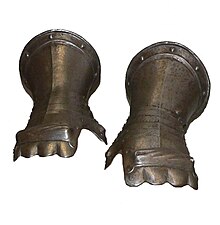Gauntlet (glove)





A gauntlet is a variety of glove, particularly one having been constructed of hardened leather or metal plates which protected the hand and wrist of a combatant in Europe between the early fourteenth century and the Early Modern period. Today it can also refer to an extended cuff covering the forearm as part of a woman's garment.
Types[]
Armour[]
Beginning in the eleventh century, European soldiers and knights relied on chain mail for protection of their bodies, and chain armor "shirts" with wide sleeves that hung to the elbow were common. However, it wasn't until the twelfth century that chain mail shirts with longer, narrower sleeves began to be worn, and these on occasion had chain mail mittens or "muffs" resembling fingerless gloves and with a pocket for the thumb (though some of these did have complete fingers as well). These attached at the lower edge of the sleeve, and protected the wearer's hands from cuts and lacerations during combat but offered no protection against crushing blows. It wasn't until the early fourteenth century that armorers began to design fully articulated plate armor: along with this development of the use of plates as a means of protecting the body from blows was the development of hand protection in the form of gauntlets made of overlapping plates of steel.[1] These were created both in the fingerless "mitten" style (which offered plate armor protection and allowed the fingers to share heat but limited the wearer's ability to move those fingers) as well as the fully fingered "glove" style (which though still ungainly and less comfortable in cold weather, permitted full use of all of the fingers).
A variety of gauntlet called a "demi-gauntlet" or "demi-gaunt" also came into use around this time. A demi-gaunt is a type of plate armour gauntlet that only protects the back of the hand and the wrist: demi-gaunts are worn with gloves made from chain mail or padded leather. The advantages of the demi-gaunt are that it allows better dexterity and is lighter than a full gauntlet, but the disadvantage is that the fingers are not as well protected.
Contemporary protective gauntlets[]

Modern protective gloves called "gauntlets" continue to be worn by metal workers and welders when handling hot or molten metals or in contexts where sparks are common. These gauntlets no longer sport the metal plates of the originals, but instead are highly insulating against heat. Similar varieties of gauntlet are worn by automotive technicians to protect their hands when handling car components, and meat and fishery butchers often wear chain mail gauntlets to protect their hands from the sharp edges of knives. Motorcyclists wear gauntlets made of leather to protect their hands from abrasion during an accident, and snowmobile drivers wear fingerless gauntlets made of nylon to protect their hands from wind and cold temperatures while driving their vehicles. Falconers wear leather gauntlets to protect their hands from the sharp claws of the birds of prey that they handle, and lastly, modern competitors in fencing, particularly those competing with the épée, routinely wear fingered gauntlets to protect their hands from possible cuts and puncture wounds from their opponents' weapons.
As clothing[]
In Western women's fashion, a gauntlet can refer to an extended cuff with little or no hand covering. Such gauntlets are sometimes worn by brides at weddings.[2]
Religious[]
In the Roman Catholic Church, the full-fingered gloves traditionally worn by the pope or other bishops are also known as gauntlets or episcopal gloves, though their use has largely been relaxed since Paul VI.
Idioms[]
The term "gauntlet" has common usage in two English expressions: to "throw down one's gauntlet" and to "run the gauntlet".
"Throw down the gauntlet"[]

To "throw down the gauntlet" is to issue a challenge. A gauntlet-wearing knight would challenge a fellow knight or enemy to a duel by throwing one of his gauntlets on the ground. The opponent would pick up the gauntlet to accept the challenge. The phrase is associated particularly with the action of the King's Champion, which officer's role was from medieval times to act as champion for the King at his coronation, in the unlikely event that someone challenged the new King's title to the throne.
"Run the gauntlet"[]
"Running the gauntlet" was a military punishment in which a soldier or sailor had to pass between a double row of comrades armed with cudgels. The expression is now generally used metaphorically. Gauntlet in this context is unrelated to the "protective glove" meaning, but is instead derived from the Swedish gatlopp ("street run").[3] Because of this difference in the derivation of the word, the expression is sometimes written "running the gantlet". In the American West, when an opponent, whether a white person or an American Indian from an enemy tribe was captured, the prisoner was given the option of 'running the gauntlet', not unlike the military punishment mentioned above. Supposedly, if the prisoner could successfully navigate the gauntlet, he was allowed to go free. Usually, however, prisoners had to run for their lives.[citation needed]
References[]
- ^ Paul F Walker (1 March 2013). History of Armour 1100-1700. Crowood. p. 124. ISBN 978-1-84797-515-7.
- ^ Wedding Planning: Wedding Accessories - Gloves|Brides.com Archived 2007-10-21 at the Wayback Machine Gauntlet Glove
- ^ Online Etymology Dictionary gauntlet (2)
External links[]
![]() Media related to Gauntlets at Wikimedia Commons
Media related to Gauntlets at Wikimedia Commons
- Gloves
- Heavy metal fashion
- Western plate armour
- Body armor

